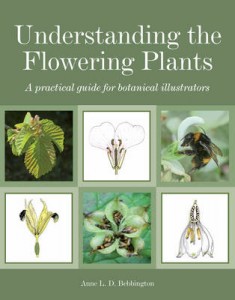Dr. Anne Bebbington trained as a botanist and worked for over 30 years for the Field Studies Council and as an environmental educator. Also an outstanding botanical illustrator, her career has traced a path between the two complementary fields, and she is a past President of the Institute of Analytical Plant Illustration. Her new book is a testament to this dual expertise.

What came first for you, botany or illustration – and how have the two interwoven throughout your career?
From an early age natural history, drawing and painting were always my favourite occupations. At university I was lucky to be able to study both botany and zoology and found that drawing the plants and animals we studied was for me the best way of describing and understanding them. After specializing in plant ecology I joined the Field Studies Council. As well as teaching environmental studies at all levels from primary pupils to undergraduates, I tutored many wild flower courses for adults both in Britain and further afield in Europe, Canada and Australia. My interest and expertise in illustration always formed an important part of my work, particularly in producing handouts and identification aids, and running short botanical illustration courses. In retirement I work as a freelance natural history illustrator but also continue to share my enthusiasm for plants running workshops and giving talks to both natural history groups and garden clubs.
You are a founder member and past President of the Institute for Analytical Plant Illustration. Tell us more about this organization?
The Institute of Analytical Plant Illustration (IAPI) promotes interest in the diversity and understanding of plants through illustration. It was founded in 2004 by the late Michael Hickey, an excellent teacher, botanist and skilled analytical illustrator. Its aim is to encourage and facilitate collaboration between botanists and artists by organizing talks, running workshops and field meetings, and setting up projects which members can contribute to.
In 2010, with IAPI support, I got together with Mary Brewin, a skilled artist, to provide a course of ten workshops combining botanical tuition with an opportunity to develop and practice appropriate illustration techniques. We hoped it would help members to:
- gain a better understanding of plants to inform their practice of the art of botanical illustration.
- develop and refine illustration techniques appropriate to different botanical subjects.
- encourage enthusiastic beginners to gain botanical knowledge and some basic art skills.
This course was very successful and raised great interest and in the last four years has resulted in the running of further courses and workshops both for IAPI and other groups and organizations.
What is the place of botanical illustration in scientific research?
Botanical illustration both in the form of photography but also drawings and painting is integral to all aspects of scientific research.
Are there any botanical subjects that you are particularly inspired to work from?
I am particularly interested in the way that plants interact with their environment and how the intricacy of their structure plays a part in their success and survival. I frequently work with my husband, a zoologist and photographer, investigating the interactions between plants and animals, particularly insects. Close observation and drawing plants out in the field is also something I really enjoy.
What are you currently engaged with in terms of your botanical illustration career?
I am currently looking at the detailed internal structure of flowers in relation to their pollination mechanisms by producing illustrations in the form of half flowers.
It’s a beautiful book and a wonderful resource for botanical information – who is the book written for?
The book should be accessible to anyone, even those with little or no scientific background. It was written for:
- botanical artists and photographers who wish to gain a better understanding of the Flowering Plants to inform their practice of the art of botanical illustration.
- anyone who works with or just enjoys plants and wants to know more about them.
Understanding the Flowering Plants: A Practical Guide for Botanical Illustrators is published by Crowood Press and is available now.
| Available now |


I was sent this book to review and immediately bought a copy for a friend. It is beautifully illustrated with both drawings and photographs and gently instructs any botanical artist into the importance of understanding the botany to accurately demonstrate key features. It seems less ‘arty’ than many other books of this type – cutting to the chase and showing the real pleasure in getting it right. This in no way compromised the aesthetic skills of composition and approach – a true blend or art and science.